
Back in the early 2010’s, Aha! took the world by storm being one of the first product management tools in the industry. Its groundbreaking focus on providing a dedicated tool for product managers was like no other at the time, and made the way for the wide array of tools we know today.
Over time however, Aha! has failed to keep up with new trends, becoming a “legacy” in the product management world. From over bloated features to a difficult UI, it, unfortunately, fell into the build trap.
If you’re ready for a new platform that will help your team practice modern product management, let’s dig into our contenders!
TL;DR
All products mentioned in this article have clear strengths and can serve as part of a product management ecosystem.
A modern product management tool must cover outcome-focused roadmaps, strong support in product discovery, easy user adoption and seamless scalability for growing teams. According to our evaluation, airfocus is best suited to cover this full set of capabilities a modern product manager needs.
What is Aha!, and why look for an alternative?
Founded in 2013 by Brian de Haaf, Aha! was the first tool of its kind. The team’s initial vision was to provide a place for product managers to understand and manage strategy through a dedicated tool - something unheard of at the time.
They launched their initial roadmaps feature a year later, and by 2018 they were already named on Deloitte’s 2018 Technology Fast 500 list. They had a clear path to growth, and have managed to build a sustainable business around it. They eventually broke up their product into Aha! Roadmaps, Aha! Ideas, Aha! Develop and Aha! Create.
How Aha! lost its way
While the idea of a tool that does it all sounds enticing - it is usually that exact thought that leads to tools becoming legacy, corporate, and bloated with features.
Aha! had a solid initial vision, but deviated when trying to do too many things. As a result, they haven’t been able to adapt to the changing and continuous learning industry of product management.
Some of the downsides consumers have noticed in Aha!:
It still works from the premise that roadmaps are timelines.
The UI is difficult to understand and navigate, as there’s an array of features presented all at once.
It combines project and product management into the same discipline.
It is difficult to bridge the gap between the multiple products, often being hit with a paywall before even being able to try them out.
Defining Aha! competitors
When it came to defining Aha! competitors, we looked at answering the following:
How does it help with roadmapping and sharing roadmaps?
How does it help with discovery?
How does it help with prioritization?
How does it help with scaling teams?
How does it help with involving other team members?
What is their pricing like?
Why these questions? It’s time to go beyond just feature-by-feature comparison and look at a product manager’s every day job.
We do a lot more than just roadmapping - we scale teams, prioritize, communicate, and work with several other stakeholders.
A good product platform should support those workflows through and through.
With these questions in mind, we looked through dozen of sources and reviews online to assess our competitor list. As a result, we've chosen the five most recognizable sources to conduct an investigation:
We used these sources to find the closest Aha! Alternatives and compared them with one another through a variable scope.
We won’t keep you waiting any longer… drum roll, please!
Here are your top 8 Aha! alternatives:
airfocus
airtable
Asana
Jira
Monday
Productboard
Roadmunk
Let’s get right into it!
1. airfocus vs Aha!

In their own words: “Every product and team is unique. That's why we created the world's first and only modular product management platform. Start simple with our ready-to-use templates and extend airfocus as you grow and scale.”
airfocus is one of “the new kids” in town - but in their short time they’ve managed to impress with their unique take on product management. airfocus understands through and through how difficult product is in practice, and have designed a tool that adapts to growing and scaling teams, providing them with a space that grows and changes with them.
From product strategy, discovery and roadmaps - all the way to insights management - they thoroughly understand that all teams and organizations need unique workspaces catered to their own needs.
Founded in: 2017
Based in: Germany
Employees: 60
Funding: $10M
Website: www.airfocus.com
How does it help with roadmapping and sharing roadmaps?
airfocus allows teams to create portfolios that break down into several team roadmaps. Both views can be shared internally and externally through easy, shareable links - putting collaboration at the forefront.
The team has taken great care at giving flexibility over how teams are able to create roadmaps, even going as far as providing pre-populated templates to get new users going in a flash.
All templates and workspaces are 100% customizable, adding to the flexibility of the platform. Whether you need different views, fields, or visibility options - you can truly turn this modular platform in the perfect product for your team.
How does it help with discovery?
airfocus has a heavy focus on customer feedback, with a (you guessed it!) customizable user portal that can be set up to engage with users directly. Once set up, you can also organize internal workflows for both feedback and ideas, so you have full visibility over who is saying what, and how this impacts your work in the future.
You can also set up custom workflows on all hierarchy levels, giving you flexibility over how your product team manages its discovery. Because of its elasticity as a product, you can use any discovery framework or method - often at multiple times and across various teams.
How does it help with prioritization?
airfocus has the most flexible prioritization configurations in any of the available product tools. Each team can customize their workspace how they see fit, so whether you love (or hate) RICE, WSJF, or a simple impact vs effort framework - you can use all of them.
After ideas have been scored, you can visualize how they compare to one another in a handy comparison chart, enabling your team to make better decisions.
Alongside that, the platform also offers a Priority Poker tool, which helps teams align around priority and focus. In it, a session can be started where team members score ideas individually, and then discuss what the best way forward is.
How does it help with scaling teams?
airfocus was specifically designed for growing and scaling teams. Its modular approach to product development means the tool can easily be adapted to new needs, frameworks, and workflows as changes happen. It does not aim to force anyone to work in a certain way, but does provide useful guidance through their templates, tool tips, videos, and various educational content.
How does it help with involving other team members?
airfocus’ easy UI makes it a breeze to collaborate with your team. They also offer forms, portals, and integrations for those team members or stakeholders that may show some friction in wanting to adopt a new tool.
They also have integrations with various other platforms such as Intercom, Jira and Asana, so you can set up a dynamic system support cross-team work.
What is airfocus pricing like?
airfocus offers four pricing plans for their product. Pricing is based on paid seats, while also offering free viewers. The smallest is $19 per user per month, billed annually. The next larger one is $69. The two upper tiers are custom pricing, also billed annually.
Pros and Cons
Pros:
Extensive integrations with development tools like Jira, Trello and AzureDevops
Ability to create and share roadmaps
Portfolio view of multiple roadmaps
Customizable fields and views
Custom prioritization frameworks + priority poker
Customer portal and insights app
Good UI, easy setup
Cons:
Modularity can take bit of time to get used to
Rating
G2: 4.4 out of 5
Capterra: 4.5 out of 5
airfocus also created a dedicated comparison page addressing the differences of Aha! and airfocus.
2. Airtable vs Aha!
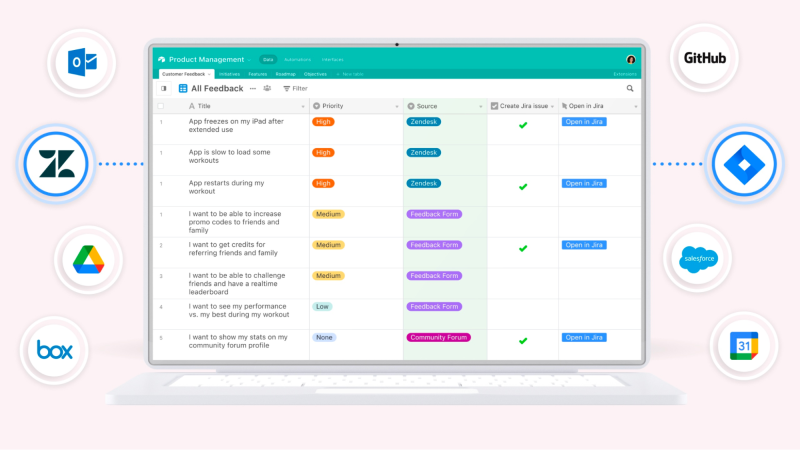
In their own words: “Accelerate work and unlock potential with powerful apps that connect your data, workflows and teams.”
Airtable’s magic lies in being able to connect everything, everywhere, all at once. With an interweaved set of databases strung together, it has the power to set up workflows for multiple teams and processes.
Founded in: 2012
Based in: United States
Employees: 1.200
Funding: $1.4B
Website: www.airtable.com
How does it help with roadmapping and sharing roadmaps?
Airtable is a highly customizable spreadsheet-style platform. While it does allow you to set up an array of different views and apps, it’s important to note that this is not a dedicated product tool. As such, setting up roadmaps requires knowing how to string databases together to display the correct information. When starting from scratch, this can have quite a lift - meaning that while it might work, it won’t scale.
Views can be shared via URLs, but all data is shared at once. This means you cannot customize what is shared, and rather requires you to create a separate database that needs to be maintained alongside your main roadmap.
How does it help with discovery?
Airtable is a process tool - not a feedback tool. While you can set up external forms to be used as a way to gather feedback, it lacks on the engagement side. There’s also a lot of manual work involved in connecting databases, potentially causing you more time trying to figure out how to set up workflows than actually using them effectively.
How does it help with prioritization?
Its customizable and flexible approach would allow you to set up any framework you want, but optimizing the algorithms would be tricky. This would require knowledge of formulas, potentially causing issues down the line if someone else were to accidentally modify them.
How does it help with scaling teams?
Airtable, while highly customizable and flexible, would run into an issue with scalability. You would need team experts to know how formulas and databases work, as opposed to it being a tool anyone can use without being afraid of potentially breaking something.
How does it help with involving other team members?
airtable’s UI is user friendly, and there should be little friction introducing it to team members.
What is airtable pricing like?
Airtable has four prices, ranging from a freemium version to enterprise based on user seats. Their second plan sits at $10 per member billed annually, while their third plan is at $20. The fourth plan is priced upon request.
Pros and cons
Pros:
Easy-to-use
Interconnected apps and workflows
Plenty of integrations to choose from
Cons:
Restrictive set up for roadmaps
Requires knowledge of connecting apps and complex databases
Has a limitation on records and file uploads
Rating
G2: 4.6 out of 5*
Capterra: 4.7 out of 5**
*1460 user reviews
**1466 user reviews
3. Asana vs Aha!
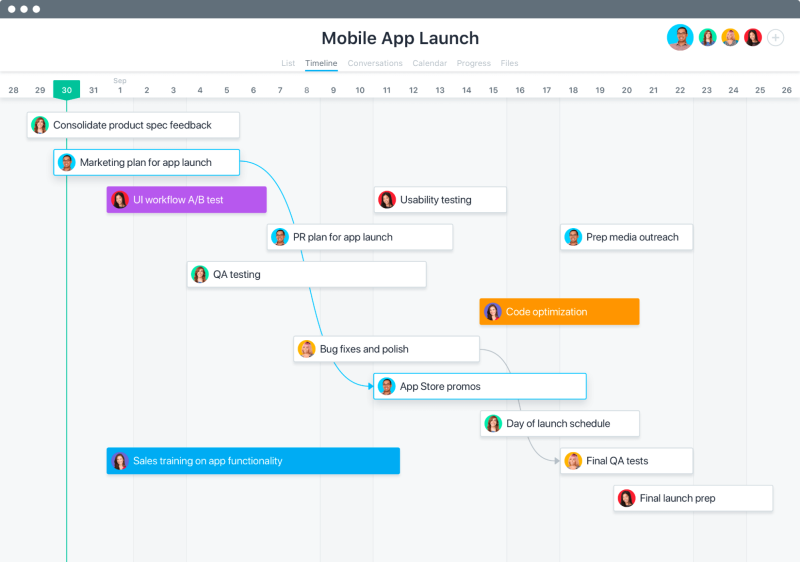
In their own words: “Teams use Asana to easily connect people, processes, and cross-functional teamwork in one place.”
Asana is a productivity tool, allowing you to manage complex work across various teams. As a project tool, its focus is to provide teams with efficiency across the board, ensuring everyone from marketing to operations is able to manage their time better.
Founded in: 2008
Based in: United States
Employees: 2.500
Funding: $453M + IPO
Website: www.asana.com
How does it help with roadmapping and sharing roadmaps?
Asana is primarily a project tool, and as such offers timeline and project-based functionality. While you are able to create a kanban-style board that is customizable, their focus is on the solution space, not the problem space.
How does it help with discovery?
While you might be able to set up an internal process to manage discovery, you wouldn’t be able to collect feedback to support your research. Asana is great at managing tasks, but difficult to connect to external forms or customer-facing tools.
How does it help with prioritization?
As a task-based tool, it does manage prioritization quite well. That said, it’s task-based prioritization. They offer custom labels and fields to work around that, making prioritization simple, but effective.
How does it help with scaling teams?
Asana’s scalability is fantastic for anyone looking for ways to manage projects across various teams. You can assign and follow various tasks and projects, and create cross-team and cross-project dependencies throughout.
How does it help with involving other team members?
Even though most people are afraid of task-management tools being rigid, Asana has gone out of its way to make it delightful. So much so, they have a special “delighting” mode you can turn on to see more unicorns, confetti, and celebratory animations. This would certainly make anyone want to come onboard, because who doesn’t like a unicorn flying across your screen, amirite?
What is Asana pricing like?
Asana offers three tiers paid per user, billed annually: free, $10,99 and $24,99.
Pros and Cons
Pros:
Easy to use
Delightful UX and UI
Scales easily
Cons:
Does not support the product management use case
Does not support now, next, later roadmaps
Does not support gathering feedback
Rating
G2: 4.3/5
Capterra: 4.5/5
4. Jira vs. Aha!

In their own words: “The #1 software development tool used by agile teams”
Jira is probably the most well known development tool, and as part of the Atlassian suite, caters to support, operations, and project teams alike. In addition, they have over 3000 integrations to choose from, putting cross-tool collaboration front and center.
Founded in: 2002
Based in: Australia
Employees: 15.300
Funding: $210M (Secondary market) + $462M (IPO)
Website: www.jira.com
*Data for Atlassian, Jira’s parent company
How does it help with roadmapping and sharing roadmaps?
Jira does have roadmapping capabilities - both board and timelines views - but those views cannot be shared outside of the Atlassian ecosystem. This means sharing your roadmap externally would be near impossible, unless you allow users to log in to your Jira account and set the correct permissions.
As a delivery tool, it allows teams to see work all the way down to the task-level, but gives less in the way of understanding outcomes.
How does it help with discovery?
While you may be able to set up a discovery board or workflow, you’ll need to set it up in a custom manner with a few integrations in mind. Much like other do-it-all tools, this requires extensive knowledge of how to connect and keep these integrations up to date and with the right level of security.
How does it help with prioritization?
Much like everything in Jira, setting up a prioritization framework is doable, but will require an IT manager to allow you to set up and manage custom fields.
How does it help with scaling teams?
Jira is probably one of the most scalable products because it is designed with that in mind. That said, remember it is not really meant to be used as a product management tool. It still requires knowledge of how to work around it, and that learning curve may be difficult for a lot of team members. It’s especially challenging for product managers without any prior Jira experience.
How does it help with involving other team members?
Atlassian always offers a wide variety of advanced permissions you can assign to team members. Its UI is tricky to navigate through, and tends to cause a lot of friction when it comes to extending the tool with business-facing team members such as marketing and sales.
A good product team must be able to work closely cross-functionally, and if others refuse to adopt your product tool, teamwork will just be that much harder.
What is Jira pricing like?
Jira is available at four different prices: free, $7,50, $14,50 per user, per month (no matter if paid annually or monthly). Lastly, an enterprise tier, only available with annual billing from 801 users at $10,70 per user per month.
Pros and cons
Pros:
Great for agile software development
Over 3000 apps and integrations available
Customization of boards, reports, timelines, and views
Good scalability with larger teams
Cons:
It is not a product management tool
Time-consuming management process
Confusing layout, configuration, and UI
Rating
G2: 4.2 out of 5
Capterra: 4.4 out of 5
5. Monday.com vs. Aha!

In their own words: “A platform built for a new way of working”
Monday.com unlocks team work by enabling collaboration through extensive connectivity and workflows. It has quickly established itself as a leader in the project and operation management world.
Founded in: 2012
Based in: Israel
Employees: 1.600
Funding: $384M + $574M (IPO)
Website: www.monday.com
How does it help with roadmapping and sharing roadmaps?
Much like the other project tools we’ve mentioned here, Monday.com also lacks a product-specific focus. It is a generalist tool that may fit various use cases at any given time, but does not specialize in product management problems. Roadmaps are timeline/gantt charts, and offers little to no flexibility in creating outcome-based roadmaps.
Their main use cases include marketing, sales, operations and project management to name a few - but product management is not one of them. That said, if you’re part of a small team, this could help your budget quite a bit.
How does it help with discovery?
You can set up a board with custom workflows. However, like the other generalist tools that require database management - you will need to know how to extensively manage formulas and databases to keep it running.
This can be quite time consuming, and as your team grows, having just one person that knows how things work can put you in a bit of a pickle.
How does it help with prioritization?
Custom scoring is difficult to set up, but they do offer flagged priorities as part of their custom functionality. As a task tool, it’s great at managing projects, but fails when it comes to understanding outcomes and problems.
How does it help with scaling teams?
Monday.com could potentially scale, provided you have several in-house residents that know how formulas, algorithms, and databases are linked up together. It can very easily break if you don’t know what you’re doing, and you could end up creating a domino effect across multiple workspaces without even knowing it.
How does it help with involving other team members?
Monday.com has gotten its usability right. The UI is easy to navigate through, even when working with complicated databases. Collaboration has been thought about through and through, so there shouldn’t be a lot of resistance from other team members to join.
What is Monday.com pricing like?
Monday.com offers five different prices. Its most basic version is free, followed by $8, $10, $16 and a custom price, respectively. All per user, per month, billed annually.
Pros and cons
Pros:
Good UI
Easy monitoring
Great tool for project management, sales and ops teams
Cons:
They do not specifically support product management as a use case
Integrations and automation are not available for the Basic pricing plan
Rating
G2: 4.7 out of 5
Capterra: 4.6 out of 5
6. Productboard vs Aha!
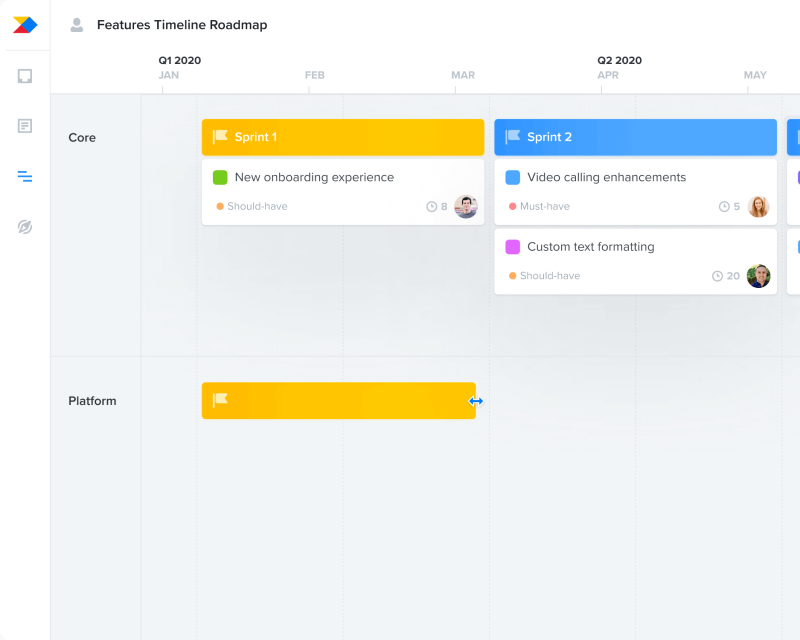
In their words: “Productboard helps product teams understand what customers need, prioritize what to build next, and align everyone around the roadmap.”
Productboard is one of the most well-known tools in the product management world. Like many of its kind, Productboard allows product managers to understand what their next strategic move might be. From building a roadmap to discovering insights from customers, it supports teams in their product management day to day.
Founded in: 2014
Based in: United States
Employees: 500
Funding: $262M
Website: www.productboard.com
How does it help with roadmapping and sharing roadmaps?
While Productboard does offer you to create roadmaps, it has some red flags waving in the background.
Their “Now, Next, Later” roadmap is actually based on releases, for which you need to adapt the labels.
They still work under the premise that a “timeline” is a roadmap
They offer an option called a “Kanban roadmap”, - which shows they don’t quite understand what Kanban or Roadmap is.
Once you manage to create a board-like or Now, Next, Later roadmap, they map features directly to the roadmap, completely bypassing the initiative level. While they do seem to be investigating initiatives, they also want to tie them directly to timelines, once again, misunderstanding the purpose of what a roadmap is.
How does it help with discovery?
Productboard seems to be giving mixed signals on this department.
While you are able to create a board to keep track of progress, and they do offer quite a neat and well-done portal and feedback management inbox, they still manage to name items on the backlog ‘features.’ This inherently sets the mindset that there is no discovery process to be made, as you’re already defining features, and not taking the time to understand problems.
How does it help with prioritization?
Productboard does offer you to set up custom fields so you can prioritize to your heart’s content, but they don’t offer pre-populated templates for easy setup. That said, if you need a simple way of prioritizing, it’s a great way to get started.
How does it help with scaling teams?
There’s two potential downsides to Productboard:
Everyone works in the same workspaces, meaning you’ll have to have the same workflows and processes as everyone else.
It can get quite expensive as you move up their tiers
However, if you’re a team with super tight workflows and have a big budget, it might just work.
How does it help with involving other team members?
It’s a bit tricky to navigate at times, but overall, the UI (particularly on their portal) is delightful.
What is their pricing like?
Productboard has four different price plans, billed per user per month. Starting at $20, continuing with $80, with the upper two plans available on request.
Pros and Cons
Pros:
Delightful experience on the user portal
Integrations with Jira, Zendesk, Intercom
Good feedback management system
Cons:
They send mixed messages around what a roadmap is
No discovery workflows
Calls everything a “feature”
Can be quite expensive
Rating
G2: 4.5 out of 5
Capterra: 4.5 out of 5
7. Roadmunk vs. Aha!
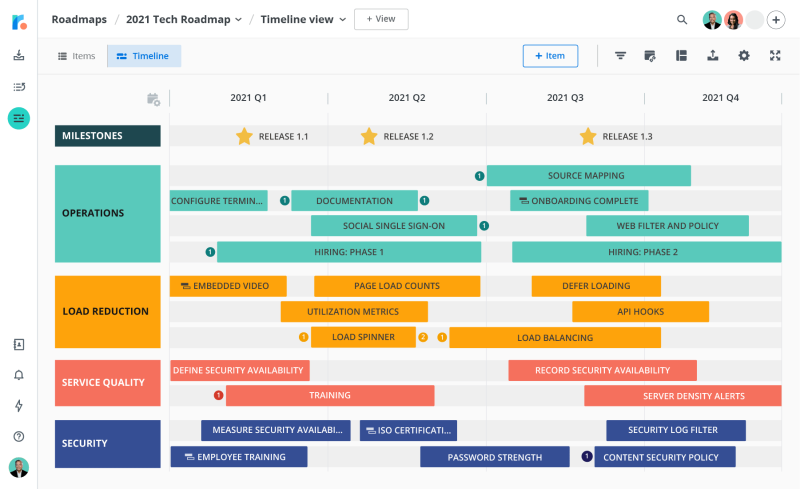
In their own words: “The end-to-end roadmapping tool. Capture customer feedback. Prioritize what to build next. And use boardroom-ready roadmaps to communicate your strategy.”
The Canadian startup Roadmunk began as a roadmap-only solution, and over time extended their offering to backlog and feedback management. Now offering a whole suite of tools, it has become a contender in the product tool world.
Founded in: 2012
Based in: Canada
Employees: 60
Funding: $1,7M (bought by Tempo at an undisclosed price)
Website: www.roadmunk.com
How does it help with roadmapping and sharing roadmaps?
Roadmunk provides an extensive library of templates, including timelines and outcome-based roadmaps across various themes, industries and project types.
Al roadmaps are easy to share, and come in formats such as CSV, PNG, HTML and publishing to a URL.
How does it help with discovery?
Roadmunk lacks some discovery focus. Their value prop indicates they can assist with “committing to ideas” - which depending on how you read that, may indicate they’re either leaning towards a feature factory, or helping you with decision-making.
They do offer a portal and feedback inbox to aid with research, but they lack extensive workflow management. There are only two statuses available on the inbox: “New” and “Processed” - with nothing in between. While it’s a good first go, it would fail scaling upwards as processes become more detailed.
How does it help with prioritization?
Roadmunk does offer prioritization methods, but limits them currently at RICE and impact vs effort. It does also offer other data points such as time estimations and revenue. If you are happy with a really simple framework, this might just work for you. However, if you wish to add more into consideration, you may find it a bit too restrictive.
How does it help with scaling teams?
Roadmunk is great for smaller teams, but its lack of customization as well limited workflows and processes, would make it hard to scale upwards. They try to force everyone into a box of what they know works (for them) - but as we know, not everyone fits into a box nicely.
They also only offer two integrations out of the box: Jira and AzureDevops. For everything else, there is an API available, but it would require your team to have the capacity to build its own custom integration with them.
How does it help with involving other team members?
It is easy to collaborate and mention other team members, but you may find it a bit difficult to increase adoption as their UI is a bit difficult to navigate through.
What is Roadmunk pricing like?
Roadmunk offers four price tiers starting at $19 per user per month, billed annually. The second and third tiers are $49 and $99 respectively. Enterprise pricing is available on request only.
Pros and cons
Pros:
Over 50+ templates available in their library
Has a feedback portal and inbox
Has integrations with Jira and Azure Devops
Cons:
Costly for small teams
No flexibility for feedback management
No scaling options
Rating
G2: 4.1 out of 5
Capterra: 4.4 out of 5
Conclusion
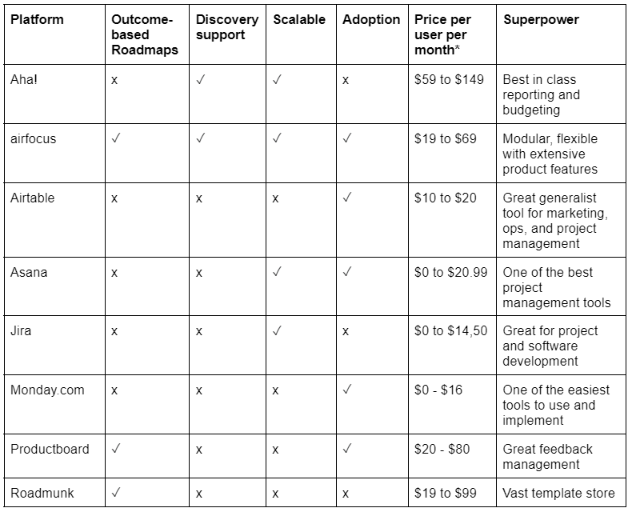
* public prices only, billed annually. All companies offer custom enterprise prices on demand.
Aha! was one of the first tools to hit the market, and they clearly dominated it initially.
However, as they grew, they seem to have gone towards old product practices, mishmashing a lot of it with project management. For old corporations who still work under that premise, it might just work. For those of us looking to establish better and more modern ways of working - there are other tools out there suited for the job.
If you want to learn more about applied modern product management, feel free to check out our academy guide on just that.
Extra: Funny ways we’ve seen Aha! misspelled
As the first tool of its kind on the market, Aha! has been around for a long time. Their staying power has led many people to search for them online. However, we’ve noticed that people often misspell Aha! when they search for it, leading to some funny takes on the tool’s name.
Here’s a little list of our favorite misspellings we’ve seen people use when searching for Aha!
A-ha - People searching for “A-ha” might be surprised when they get results for the 80s pop band instead of the product management tool.
Ha! - We’re missing the “A” in Aha! here — maybe it will show up later in the list?
Ah ha - This version gives you a chance to pause and take a breath.
Ahaa - Those searching for “ahaa” have simply swapped the exclamation with an extra “a” — maybe their keyboard needs to be checked.
Aah - We’ve found the missing “A” from the second option on our list!
Aa a - People searching for “ha a” have things just a little bit backward.
Ha ha - A comedic take on Aha!’s spelling, and undoubtedly the funniest on our list.
Ahas - Since Aha! has several tools (Aha! Roadmaps, Aha! Ideas, Aha! Develop, and Aha! Create), this spelling could cover a search for all their tools at once!

Andrea Saez
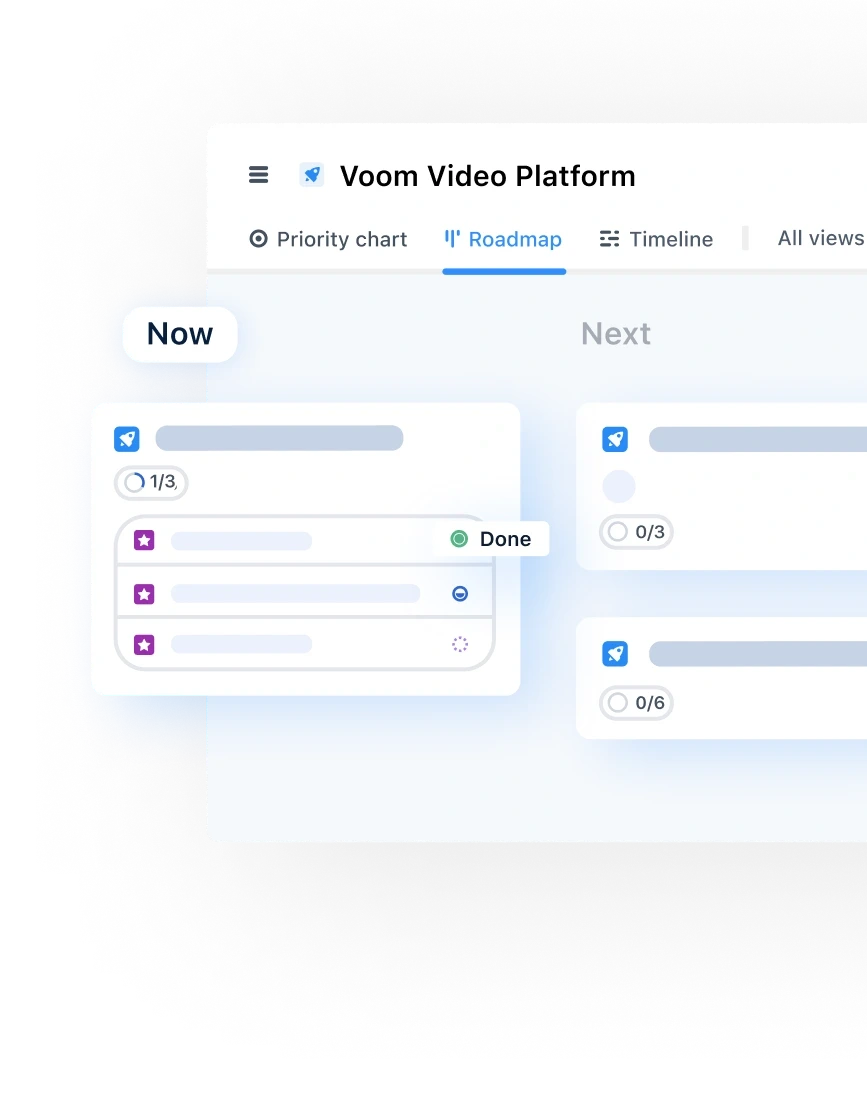
Read also






Experience the new way of doing product management

Experience the new way of doing product management



